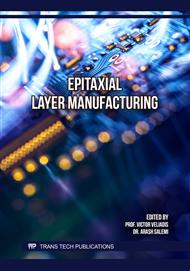[1]
G. Gelineau, C. Masante, E. Rolland, S. Barbet, L. Corbin, A. André, V. Amalbert, S. Caridroit, M. Delcroix, S. Huet, A. Moulin, V. Prudkovskiy, N. Troutot, S. Rouchier, L. Turchetti, K. Mony and J. Widiez, CEA-Leti, Univ. Grenoble Alpes, "Processing and electrical characterization of SiC-on-Insulator structures", ICSCRM 2023, (Sep 2023), Sorrente, Italy. ffcea-04557058
DOI: 10.4028/p-ydh8qb
Google Scholar
[2]
J. Yang, B. Hamelin, and F. Ayazi, J. of Microelectromechanical Systems, 29, (2020) 1473–82.
Google Scholar
[3]
Lutong Cai, Jingwei Li, Ruixuan Wang, and Qing Li, Photonics Research 10, no. 4 (2022).
Google Scholar
[4]
Ashwin K. Samarao and Farrokh Ayazi, IEEE Trans Electron Devices 59 (2012) 87-93.
Google Scholar
[5]
S. Sapienza, M. Ferri, L. Belsito, D. Marini, M. Zielinski, F. La Via and A.Roncaglia, Micromachines (2021), 12, 1072.
DOI: 10.3390/mi12091072
Google Scholar
[6]
C. Calabretta, V. Scuderi, C. Bongiorno, A. Cannizzaro, R. Anzalone, L. Calcagno, M. Mauceri, D. Crippa, S. Boninelli, and F. La Via, Cryst. Growth Des., 22 (2022) 4996−5003 .
DOI: 10.1021/acs.cgd.2c00515
Google Scholar
[7]
T. Kimoto and J.A. Cooper, Fundamentals of Silicon Carbide Technology, 1st ed.; John Wiley & Sons: Singapore, 2014.
Google Scholar
[8]
Y.A. Vodakov, E.N. Mokhov, M.G. Ramm, A.D. Roenkov, Springer Proceedings in Physics. Washington, DC, USA: Third International Conference on Amorphous and Crystalline Silicon Carbide and Other Group IV-IV Materials; 1990, 56 (1992) 329-334.
DOI: 10.1007/978-3-642-84402-7_50
Google Scholar
[9]
T.A. Kuhr, JinQiang Liu, Hun Jae Chung and M. Skowronski, J. Appl. Phys. 92, (2002) 5863-71.
Google Scholar
[10]
U. Forsberg, Ö. Danielsson, A. Henry, M.K. Linnarsson and E. Janzén, J. Cryst. Growth, 236 (2002) 101-112.
DOI: 10.1016/s0022-0248(01)02198-4
Google Scholar
[11]
W. Chen, K.-y. Lee, and M. Capano, J. Cryst. Growth, 297 (2006) 265-71.
Google Scholar
[12]
D.J. Larkin, P.G. Neudeck, J.A. Powell, L.G. Matus, Appl. Phys. Lett. 65 (1994) 1659.
Google Scholar
[13]
R. Arvinte, M. Zielinski, T. Chassagne, M. Portail, A. Michon, P. Kwasnicki, S.Juillaguet and H. Peyre, Mat. Sci. Forum, 821 (2015) 149-52.
DOI: 10.4028/www.scientific.net/msf.821-823.149
Google Scholar
[14]
A.O. Konstantinov, C. Hallin, B. Pécz, O. Kordina and E. Janzén, J. Cryst. Growth, 178 (1997) 495-504.
DOI: 10.1016/s0022-0248(97)00007-9
Google Scholar


